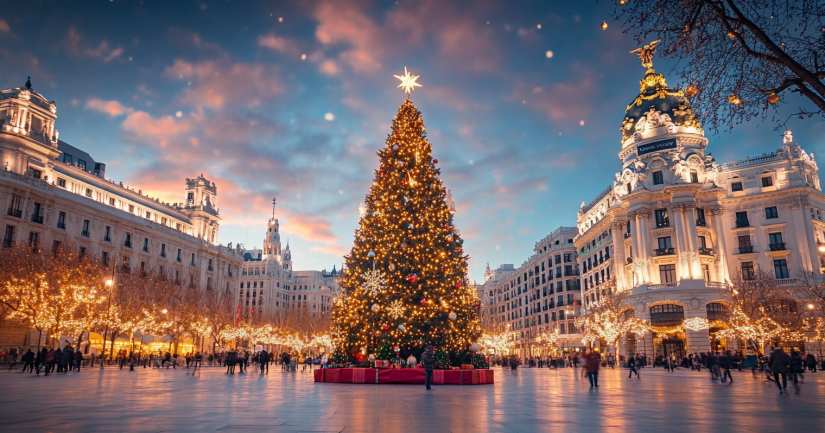
Dive into the festive spirit with our Spanish Christmas Quiz – Test Your Knowledge of Festive Traditions in Spain! Spanish Christmas Quiz fans, get ready to explore the rich traditions, delicious foods, and unique customs that make Christmas in Spain a truly magical celebration! But how much do you really know about Spain’s Christmas traditions, festive foods, and seasonal celebrations? This quiz will challenge your knowledge of Spanish holiday customs, historical traditions, and cultural festivities!
The Christmas season in Spain begins on December 8th, with the Feast of the Immaculate Conception, and lasts until January 6th, ending with the Three Kings’ Day (Día de los Reyes Magos). Families gather for Nochebuena (Christmas Eve), one of the most important nights of the season, which includes a big family feast and Midnight Mass (La Misa del Gallo).
Want to explore even more European holiday traditions? Head to the French Christmas Quiz or celebrate in German style with German Christmas Quiz – a great way to expand your festive horizons! If this quiz made you smile you’ll definitely want to check out Christmas Science And Nature Quiz for a funny twist. You’ll daydreaming as you compare your results and maybe see how funny life can be. Then saunter over to How Cool Am I Quiz to see how your answers stack up.
Begin Your Spanish Christmas Quiz Journey
How Spain Celebrates Christmas
On December 22nd, Spain celebrates the El Gordo Christmas Lottery, one of the world’s largest and oldest lotteries. Many Spaniards participate in hopes of winning a prize, and the event is broadcast nationwide. But do you know which city in Spain hosts a massive living Nativity performance each year? This quiz will put your Spanish Christmas traditions knowledge to the test!
Traditional Spanish Christmas Foods
A Spanish Christmas is not complete without an incredible feast. Families enjoy a lavish dinner on Nochebuena, featuring dishes such as roast lamb, seafood, and jamón ibérico. Desserts play a big role in Spanish holiday celebrations, with turrón (almond nougat), polvorones (crumbly shortbread cookies), and Roscón de Reyes (Three Kings’ Cake) being festive favorites.
During New Year’s Eve, a unique Spanish tradition is eating 12 grapes at midnight, one for each stroke of the clock, bringing good luck for the year ahead. But do you know which Spanish drink is commonly enjoyed during the Christmas season? This quiz will challenge your knowledge of Spanish Christmas food traditions!
Spanish Christmas Symbols and Folklore
Nativity scenes, known as Belénes, are displayed in homes, churches, and public squares across Spain, often featuring intricate details and moving figurines. One of the most unique and humorous Christmas traditions is the Caganer, a small figure hidden in Catalan Nativity scenes. This quirky tradition dates back centuries and symbolizes good fortune and fertility for the coming year.
But do you know which Spanish region celebrates Christmas with fire-jumping rituals? This quiz will test your Spanish Christmas folklore knowledge!
Are You Ready for the Ultimate Spanish Christmas Quiz?
Think you know Spain’s festive traditions, holiday foods, and Christmas folklore? Do you remember which Spanish city has a Christmas market dating back to the 18th century? Can you name the famous Spanish Christmas lottery song sung by schoolchildren?
This Spanish Christmas Quiz will challenge your knowledge of Christmas customs, seasonal treats, and cultural celebrations in Spain! Take the quiz now and see if you’re a true Spanish Christmas expert!
Get into the festive spirit with our Christmas Quizzes! Test your Christmas Trivia, then discover What You Want For Christmas!
Spanish Christmas – FAQ
Spanish Christmas celebrations are rich with traditions. They typically begin with the Feast of the Immaculate Conception on December 8 and culminate with the Feast of the Epiphany on January 6. Key customs include the decoration of homes with nativity scenes (belénes), the singing of Christmas carols (villancicos), and enjoying festive meals with family and friends.
The “Caga Tió,” or “pooping log,” is a unique Catalonian tradition. The log “poops” out presents, symbolizing generosity and the spirit of giving during the festive season.
In Spain, New Year’s Eve, known as “Nochevieja,” is celebrated with a unique tradition: eating twelve grapes at midnight, one for each chime of the clock. Each grape represents good luck for the upcoming month. Gatherings with family and friends are common, often accompanied by fireworks and toasts to welcome the new year.
